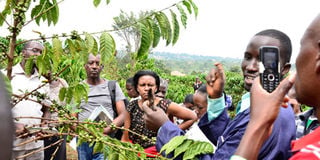New coffee variety will be drought resistant

Farmers look on as a coffee expert explains the agronomy of the crop. Farmers in Luweero are now aiming at boosting production. (Representational picture). PHOTO/RACHEL MABALA.
What you need to know:
The three new varieties are named Naro 8, 9 and 10 each with unique attributes meant to benefit farmers and exporters.
Uganda is considered Africa’s second best coffee producer with the produce having good qualities and aroma which attracts the world market.
Statistics from Uganda Coffee Development Authority (UCDA) indicate that Uganda’s coffee export earnings as per September were $34.7m (Shs125bn) a decline compared to August’s earning of $46.3m (Shs169bn).
More than 80 per cent of the coffee produced in Uganda is Robusta, a variety that is mostly grown on the lowland areas but there is also Arabica which is grown on the slopes of mountain Elgon and in Zombo district in West Nile on high altitude areas.
Coffee varieties
However, scientists majoring in breeding coffee varieties resistant to diseases say the plant is also threatened by climate change effects of prolonged drought thereby hindering farmers in some parts of the country from engaging in coffee growing. As such, the scientists have discovered wild Robusta coffee varieties growing in various forests in the country which they intend to use to breed varieties that will grow well in drought stricken areas as well as resistant to the coffee pests and diseases.
Scientists picked this idea from a research project carried out by a PhD student Catherine Kiwuka who discovered wild coffee plants that are drought-resistant in an almost-vanished Zoka forest located in Adjumani District in West Nile region.
Wild Robusta coffee
Kiwuka and team studied these populations for drought stress in a screening test in which they exposed 148 wild and cultivated varieties to wet and dry conditions. The effect of water shortage on the leaf growth differed significantly between the genetic groups.
The plants that showed the least response to a high or low level of precipitation were the most drought-resistant. They concluded that these wild varieties are suited for the breeding of drought-resistant coffee plants.
The research group also established that the wild Robusta-varieties in Uganda are of a similar quality to Arabica. Finding drought-resistant wild coffee plants is a way to address this issue but this requires those plants to actually exist.
Researchers’ plot
Dr Pascal Musoli, the head of coffee breeding at the National Coffee Research Institute (NaCORI) while speaking to Seeds of Gold noted that Kiwuka carried out her research under his supervision. According to him, the wild coffee varieties are spread in a number of natural habitats in the country which include Zoka forest, Mabira forest in central Uganda, Kibale forest in Hoima and Zombo natural habitat in West Nile among others.
The team is in the process of identifying genes from these wild varieties which can be transferred to the varieties developed in the institute for both disease and drought resistance using biotechnology approach.
At the moment, they are still studying the characteristics of the genes and how best to carry out the research in order to develop coffee varieties with stacked traits.
The varieties
In 2009, scientists at the institute released seven coffee varieties namely Kituuza Robusta – KR 1 to 7 resistant to the coffee wilt disease.
Scientists bred these varieties to address the coffee wilt disease which has been a major challenge to farmers growing the plant as well as for increased yield capacity. However in 2017, Dr Musoli and team released a set of three varieties which are high yielding and resistant to coffee wilt disease. The varieties were launched during the Seeds of Gold Farm Clinic in 2019 and are being multiplied by nursery operators for farmer use.
The three new varieties are named Naro 8, 9 and 10 each with unique attributes meant to benefit farmers and exporters. If well managed, Naro 8 has the potential of producing 5.6 kilogrammes per tree. Naro 9 has the potential of producing 8 tonnes per acre which translated into 9 kilogrammes per tree whereas Naro 10, which is the best of all the three varieties, gives a farmer 10 tonnes per hectare which translates into 10 kilogrammes per tree.
These varieties according to Dr Musoli are resistant to the coffee wilt disease and leaf rust but farmers can only be able to achieve bumper harvest if they follow good agronomy practices.




